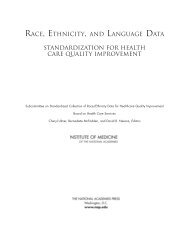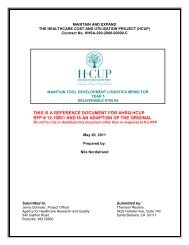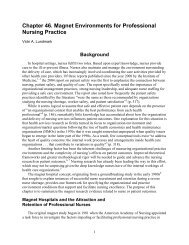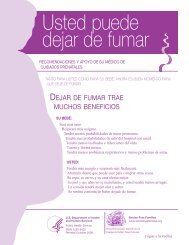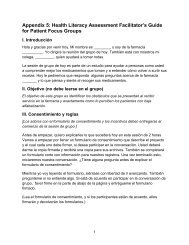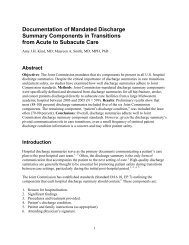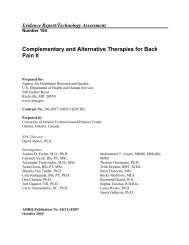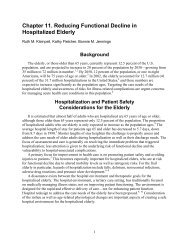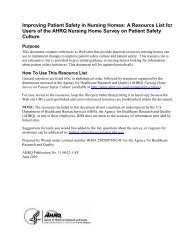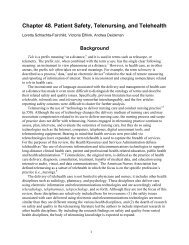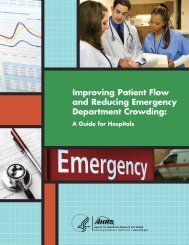Stories of Success: Using CUSP To Improve Safety - Agency for ...
Stories of Success: Using CUSP To Improve Safety - Agency for ...
Stories of Success: Using CUSP To Improve Safety - Agency for ...
You also want an ePaper? Increase the reach of your titles
YUMPU automatically turns print PDFs into web optimized ePapers that Google loves.
educing infections, but were discovering through the literature that there was more to do to get<br />
even better results. They realized they needed to develop a maintenance bundle.<br />
The Target Zero launch generated the momentum <strong>for</strong> these teams to expand and to evolve into<br />
permanent per<strong>for</strong>mance improvement (PI) teams focused around specific HAIs. One would deal<br />
with both CLABSI and CAUTI prevention because they required the same interdisciplinary cast:<br />
representatives from all departments at both hospitals, including home health and hospice. The<br />
VAP team dealt only with ventilators in the ICU, and thus had a more specialized set <strong>of</strong> clinical<br />
members: ICU nurses, intensivists, pulmonologists, respiratory therapists, pharmacists, medical<br />
directors <strong>of</strong> IC, and pharmacy. Nurses and respiratory therapists led the VAP team, and front line<br />
nurses led the CLABSI/CAUTI team. A third PI team was <strong>for</strong>med to focus on hand hygiene.<br />
Bryan, who had spent 15 years in staff development and nurse education, described the importance<br />
<strong>of</strong> thought leaders in a relational context. “Nursing is a lot about relationships, and I work<br />
through key thought leaders. We made sure we had thought leaders on our PI teams. They are the<br />
movers and shakers: they make things happen here, they know how to get things done. They are<br />
all over the hospital, some are front line.” Carroll added, “They’re also the early adopters, the<br />
mavericks who are motivated to make change. We try and harness their passion on teams. We<br />
help them do it as a system and not just as one individual.”<br />
The biggest challenge, in Parker’s view, was creating the expectation that zero was achievable.<br />
“Nurses advocated <strong>for</strong> patients and got the rest <strong>of</strong> the team to buy into Target Zero. On a day-today<br />
basis, the process was led by Infection Prevention.” Bryan provided guidance in teams’<br />
literature searches and discussions but, she said, let them come to their own conclusions so that,<br />
“now they owned it, ran with it, and owned the success.” Carroll, whose background was QI,<br />
said, “These people have day jobs, they can’t learn all these different methods. We steal from all<br />
methods, simplify them, make them user-friendly, teach the basics, and pull in tools as needed.”<br />
The teams used the AHRQ Hospital Survey <strong>of</strong> Patient <strong>Safety</strong> Culture <strong>for</strong> everyone in the hospital<br />
to measure Shore Health’s baseline. Each department analyzed their own results, drilled down to<br />
find the reasons <strong>for</strong> them, and developed plans <strong>for</strong> improvement. Teams mapped current<br />
processes; identified strengths, weaknesses and opportunities <strong>for</strong> improvement; and developed<br />
plans. They revised their standards and protocols according to best practices.<br />
When they had begun seeking HAI bundles in 2008, the Michigan Keystone Project had been<br />
getting some press regarding their CLABSI success, and Shore Health had implemented their<br />
CLABSI insertion bundle and checklist. Now the CLABSI team developed a maintenance<br />
bundle and revised Shore Health’s policies accordingly: dressing, daily assessment,<br />
chlorhexidine patch, changing lines inserted under emergency conditions, etc. The Institute <strong>for</strong><br />
Healthcare <strong>Improve</strong>ment had a VAP bundle that they implemented.<br />
Shore Health was on its own with prevention <strong>of</strong> CAUTI, their most frequent infection, which<br />
they had tried <strong>for</strong> years to eliminate. The PI team concluded that the most important thing was to<br />
get catheters out as soon as possible. They developed a protocol that switched the default setting:<br />
Nursing could take it out as soon as possible, and an order had to be written to keep it in. This<br />
change required an extensive education ef<strong>for</strong>t with physicians and nurses, and took time to get<br />
through the medical staff and Medical Executive Committee. In the year since its<br />
implementation, Shore Health has had only four CAUTIs, down from nine in 2010.<br />
18



